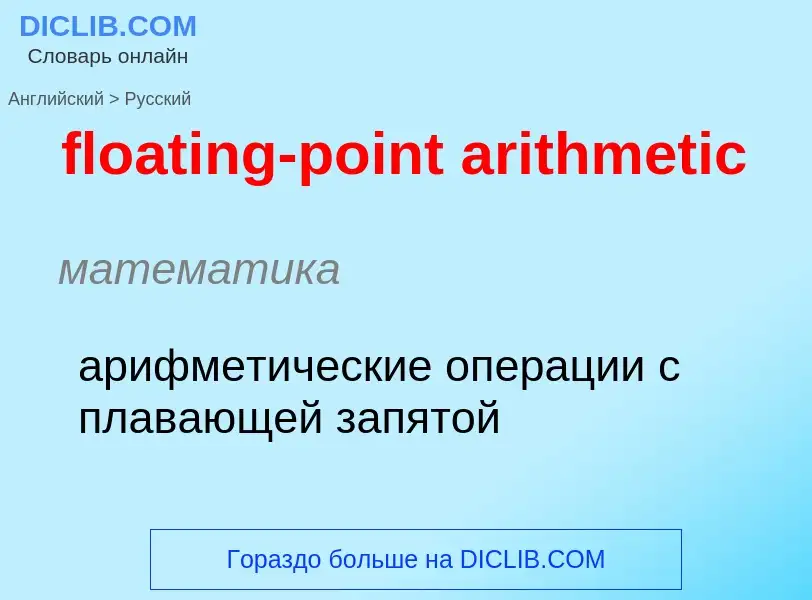Перевод и анализ слов искусственным интеллектом ChatGPT
На этой странице Вы можете получить подробный анализ слова или словосочетания, произведенный с помощью лучшей на сегодняшний день технологии искусственного интеллекта:
- как употребляется слово
- частота употребления
- используется оно чаще в устной или письменной речи
- варианты перевода слова
- примеры употребления (несколько фраз с переводом)
- этимология
floating-point arithmetic - перевод на русский
математика
арифметические операции с плавающей запятой
общая лексика
число с плавающей запятой
общая лексика
с плавающей запятой [точкой]
вычислительная техника
с плавающей точкой
Смотрите также
общая лексика
плавающая запятая [точка]
система представления и обработки действительных чисел в компьютере. Позволяет выводить их с заданным числом десятичных цифр. Соответственно говорят о реализованной в компьютере арифметике с плавающей запятой [точкой]
запятая плавающая
Смотрите также
математика
представление с плавающей запятой
общая лексика
математический сопроцессор
специализированный процессор, выполняющий над данными математические операции
синоним
Смотрите также
математика
заданная точность
общая лексика
число с фиксированной запятой
математика
повышенная точность
Определение
Википедия
In computing, floating-point arithmetic (FP) is arithmetic that represents real numbers approximately, using an integer with a fixed precision, called the significand, scaled by an integer exponent of a fixed base. For example, 12.345 can be represented as a base-ten floating-point number:
In practice, most floating-point systems use base two, though base ten (decimal floating point) is also common.
The term floating point refers to the fact that the number's radix point can "float" anywhere to the left, right, or between the significant digits of the number. This position is indicated by the exponent, so floating point can be considered a form of scientific notation.
A floating-point system can be used to represent, with a fixed number of digits, numbers of very different orders of magnitude — such as the number of meters between galaxies or between protons in an atom. For this reason, floating-point arithmetic is often used to allow very small and very large real numbers that require fast processing times. The result of this dynamic range is that the numbers that can be represented are not uniformly spaced; the difference between two consecutive representable numbers varies with their exponent.
Over the years, a variety of floating-point representations have been used in computers. In 1985, the IEEE 754 Standard for Floating-Point Arithmetic was established, and since the 1990s, the most commonly encountered representations are those defined by the IEEE.
The speed of floating-point operations, commonly measured in terms of FLOPS, is an important characteristic of a computer system, especially for applications that involve intensive mathematical calculations.
A floating-point unit (FPU, colloquially a math coprocessor) is a part of a computer system specially designed to carry out operations on floating-point numbers.

![Single-precision floating-point numbers on a [[number line]]: the green lines mark representable values. Single-precision floating-point numbers on a [[number line]]: the green lines mark representable values.](https://commons.wikimedia.org/wiki/Special:FilePath/A number line representing single-precision floating point's numbers and numbers that it cannot display.png?width=200)
![signs]] of representable values signs]] of representable values](https://commons.wikimedia.org/wiki/Special:FilePath/FloatingPointPrecisionAugmented.png?width=200)
![Z3]] computer, which uses a 22-bit binary floating-point representation Z3]] computer, which uses a 22-bit binary floating-point representation](https://commons.wikimedia.org/wiki/Special:FilePath/Konrad Zuse (1992).jpg?width=200)
![[[Leonardo Torres y Quevedo]], who proposed a form of floating point in 1914 [[Leonardo Torres y Quevedo]], who proposed a form of floating point in 1914](https://commons.wikimedia.org/wiki/Special:FilePath/Quevedo 1917.jpg?width=200)

